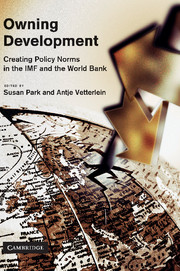Book contents
- Frontmatter
- Contents
- List of figures
- List of tables
- List of contributors
- Preface and acknowledgements
- List of acronyms and abbreviations
- Part One Introduction
- Part Two Norm emergence
- 2 Internal or external norm champions: the IMF and multilateral debt relief
- 3 From three to five: the World Bank's pension reform policy norm
- 4 The strategic social construction of the World Bank's gender and development policy norm
- Part Three Norm stabilization
- Part Four Norm subsiding
- Part Five Conclusion
- Bibliography
- Index
3 - From three to five: the World Bank's pension reform policy norm
Published online by Cambridge University Press: 02 December 2010
- Frontmatter
- Contents
- List of figures
- List of tables
- List of contributors
- Preface and acknowledgements
- List of acronyms and abbreviations
- Part One Introduction
- Part Two Norm emergence
- 2 Internal or external norm champions: the IMF and multilateral debt relief
- 3 From three to five: the World Bank's pension reform policy norm
- 4 The strategic social construction of the World Bank's gender and development policy norm
- Part Three Norm stabilization
- Part Four Norm subsiding
- Part Five Conclusion
- Bibliography
- Index
Summary
Introduction
The problem of old age security and the resulting World Bank suggestions for pension system design emerged as a hot topic in the development community in the 1990s. After the fast ascension of the World Bank's three-pillar pension reform model as the state of the art in the early 1990s, external criticism as well as experiences on the ground led the Bank to reformulate its position and suggest a five-pillar pension reform model in 2005. This chapter traces the origins of the Bank's engagement in pension reform and the development of a three-pillar pension model, which was still rooted in the old Washington Consensus of fiscal discipline, reordering public expenditure priorities and securing property rights (see chapter 1). The chapter then traces the emergence of a global old age security policy norm that takes the steps of the norm circle into account (as outlined in chapter 1). In particular, criticism of the Bank's suggestions and the subsequent reformulation of the three-pillar model within the Bank are discussed. This process of norm contestation through arguing and negotiation over the norm's meaning and value contributes to its broader social acceptance and stabilization (Wiener 2009: 12). As demonstrated below, the policy norm of old age security is now in the stabilization phase: statutory pensions provided by, or regulated by, the state through multi-pillar pension systems have come to be taken for granted as a policy norm around the world regardless of a country's level of development.
- Type
- Chapter
- Information
- Owning DevelopmentCreating Policy Norms in the IMF and the World Bank, pp. 48 - 69Publisher: Cambridge University PressPrint publication year: 2010
- 4
- Cited by



